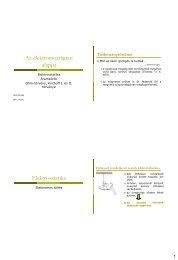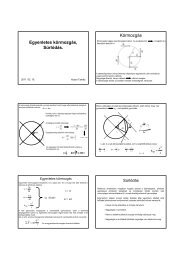Electromagnetic spectrum and the LASER
Electromagnetic spectrum and the LASER
Electromagnetic spectrum and the LASER
You also want an ePaper? Increase the reach of your titles
YUMPU automatically turns print PDFs into web optimized ePapers that Google loves.
<strong>Electromagnetic</strong> <strong>spectrum</strong> <strong>and</strong><br />
<strong>the</strong> <strong>LASER</strong><br />
September 2011<br />
Zoltán Ujfalusi<br />
University of Pécs, Faculty of Medicine,<br />
Dept. Biophysics<br />
Scientists<br />
physicists, chemists, astronomers<br />
• Sir Isaac Newton<br />
• Sir William Herschel<br />
• Johann Wilhelm Ritter<br />
• Joseph von Fraunhofer<br />
• Robert Wilhelm Bunsen<br />
• Gustav Robert Kirchhoff<br />
• Albert Einstein<br />
• Louis-Victor de Broglie<br />
• James Clerk Maxwell<br />
• Heinrich Rudolf<br />
- dispersion (1664)<br />
- IR (1800)<br />
- UV (1801)<br />
- lines in <strong>the</strong> solar spectra (1814)<br />
- interpretation of lines (1861)<br />
- interpretation of lines (1861)<br />
- light quantum (photon) (1904)<br />
- matter-waves (1924)<br />
- EM radiation <strong>the</strong>oretically (1864)<br />
- EM radiation pragmatically (1888)<br />
Huygens-Fresnel principle<br />
1. All points on a wave front can be considered as<br />
point sources for <strong>the</strong> production of spherical<br />
secondary wavelets.<br />
2. The interference of <strong>the</strong> secondary wavelets<br />
determines <strong>the</strong> fur<strong>the</strong>r behaviour of <strong>the</strong> wave.<br />
Transversal<br />
wave<br />
E<br />
B<br />
x<br />
x<br />
The light<br />
<strong>Electromagnetic</strong> wave<br />
magnetic field<br />
strength- vector<br />
electric field strength -<br />
vector<br />
wavelength<br />
The vectors of <strong>the</strong> electric <strong>and</strong> <strong>the</strong> magnetic gradients<br />
are perpendicular to each o<strong>the</strong>r <strong>and</strong> to <strong>the</strong> direction of<br />
<strong>the</strong> propagation of <strong>the</strong> wave.<br />
• James Clerk Maxwell (1864)<br />
verified <strong>the</strong>ir existence <strong>the</strong>oretically.<br />
• Heinrich Rudolf (1888) confirmed<br />
<strong>the</strong>ir existence experimentally.<br />
Interaction of <strong>the</strong> light with matter<br />
• Quanted energy uptaking (photon)<br />
• Interaction of electromagnetic wave<br />
with atomic system (matter):<br />
• reflection<br />
• absorption<br />
• transmission<br />
• (scattering)<br />
1
The dual nature of <strong>the</strong> light<br />
Wave<br />
(propagation)<br />
• Diffraction<br />
• Interference<br />
• Polarization<br />
Particle<br />
(interaction)<br />
• photoeffect<br />
• Compton-effect<br />
Albert Einstein (1905) : photoelectric effect<br />
photon (light quantum), its energy: E = h·n (or E = h·f)<br />
Louis-Victor de Broglie (1924) : Matter-waves <strong>the</strong>ory<br />
(All materials have wave nature as well.)<br />
λ = h/p, where p is <strong>the</strong> impulse => λ = h/m·v<br />
Polarization<br />
Important physical quantities <strong>and</strong><br />
relations<br />
Frequency: n (1/s)<br />
Wavelength:<br />
� (m)<br />
Wavenumber: n (cm-1 )<br />
c<br />
v<br />
1<br />
�<br />
Energy: E (J) h . n<br />
Extinct. coeff.:� (M -1 cm -1 or (mg/ml) -1 cm -1 )<br />
a<br />
Interference<br />
�x � s � s � a�<br />
sin�<br />
1<br />
2<br />
Einstein: energy of a photon (light-quantum)<br />
To achieve max. gain: To achieve max. weakening:<br />
1<br />
a� sin� � n�<br />
� a�<br />
� � ( n � ) ��<br />
sin 2<br />
Linearly polarized light<br />
2
Praya dubia<br />
Joseph von Fraunhofer<br />
(1787–1826)<br />
Types of <strong>the</strong> luminescence<br />
Bathocyroë<br />
Atolla vanhoeffeni<br />
Line spectra (emission) of some elements<br />
He<br />
Hg<br />
Na<br />
Ne<br />
Ar<br />
<strong>LASER</strong> HISTORY IN A NUTSHELL<br />
Light Amplification by Stimulated Emission of Radiation<br />
1917 - Albert Einstein: <strong>the</strong>oretical prediction of stimulated emission<br />
1946 - G. Meyer-Schwickera<strong>the</strong>r: first eye surgery with light<br />
1950 - Arthur Schawlow <strong>and</strong> Charles Townes: emitted photons may be in <strong>the</strong><br />
visible range<br />
1954 - N.G. Basow, A.M. Prochorow, <strong>and</strong> C. Townes: ammonia maser<br />
1960 - Theodore Maiman: first laser (ruby laser)<br />
1964 - Basow, Prochorow, Townes (Nobel prize): quantum electronics<br />
1970 - Arthur Ashkin: laser tweezers<br />
1971 - Dénes Gábor (Nobel prize): holography<br />
1997 - S. Chu, W.D. Phillips <strong>and</strong> C. Cohen-Tanoudji (Nobel prize): atom cooling<br />
with laser<br />
3
E 2<br />
r(n)<br />
E 1<br />
Laser principles I. Stimulated emission<br />
Elementary radiative processes:<br />
1. Absorption 2. Spontaneous emission 3. Stimulated emission<br />
B 12<br />
•Frequency of transition:<br />
n 12=N 1B 12r(n)<br />
•�E= E 2-E 1=hn<br />
energy quantum<br />
is absorbed.<br />
N 2<br />
N 1<br />
Explanation: two-state atomic or molecular system<br />
E 1, E2 : energy levels, E2>E1<br />
r(n) : spectral power density of external field<br />
N 1, N2 : number of atoms, molecules on <strong>the</strong> given energy level<br />
B 12, A21, B21: transition probabilities between energy levels (Einstein coefficients), B12 = B21<br />
A 21<br />
•Frequency of transition:<br />
n 21=N 2A 21<br />
•E 2-E 1 photons<br />
radiate independently<br />
in all directions.<br />
r(n)<br />
B 21<br />
•Frequency of transition:<br />
n 21=N 2B 21r(n)<br />
•Upon external stimulation.<br />
•Field energy increases.<br />
•Phase, direction <strong>and</strong><br />
frequency of emitted <strong>and</strong><br />
external photons are identical.<br />
Laser principles III. Optical resonance<br />
End mirror<br />
Pumping<br />
Active medium<br />
d=n�/2<br />
Partially<br />
transparent mirror<br />
Resonator:<br />
•two, parallel planar (or concave) mirrors<br />
•Couples part of <strong>the</strong> optical power back in <strong>the</strong> active medium<br />
•Positive feedback -> self-excitation -> resonance<br />
Types of laser<br />
Based on active medium:<br />
1. Solid state lasers<br />
Crystals or glasses doped with metal ions; Ruby, Nd-YAG, Ti-zaphire<br />
Red - infrared spectral range; CW, Q-switched modes, high power<br />
2. Gas lasers<br />
Best known: He-Ne laser (10 He/Ne). Small energy, wide use<br />
CO 2 laser: CO 2-N 2-He mixture; �~10 µm; enormous power (100 W)<br />
Laser beam<br />
3. Dye lasers<br />
Dilute solution of organic dyes (e.g., rhodamine, coumarine); pumped with ano<strong>the</strong>r laser<br />
Large power (in Q-switched mode); Tunable<br />
4. Semiconductor lasers<br />
No need for resonator mirrors (internal reflection)<br />
Red, IR spectral range. Large CW power (up to 100 W)<br />
Beam characteristics not ideal. Wide use due to small size.<br />
Laser principles II. Population inversion<br />
•Amplification depends<br />
on <strong>the</strong> relative population<br />
of energy levels<br />
E 1<br />
E 0<br />
A<br />
F<br />
Active<br />
medium F+dF<br />
dz<br />
Thermal equilibrium Population inversion<br />
•Population inversion only<br />
in multiple-state systems!<br />
•Pumping: electric,<br />
optical, chemical energy<br />
1. Small divergence<br />
Parallel, collimated beam<br />
E 2<br />
Pumping<br />
E 0<br />
E 1<br />
E 0<br />
E 1<br />
Fast relaxation<br />
Metastable state<br />
Properties of laser<br />
2. High power<br />
In continuous (CW) mode: tens, hundreds of watts (e.g., CO 2)<br />
Q-switched mode: instantaneous power is enormous (GW)<br />
Large spatial power density due to small divergence<br />
3. Small spectral width<br />
“Monochrome”<br />
Large spectral power density<br />
4. Polarized<br />
5. Possibility of very short pulses<br />
ps, fs<br />
Laser transition<br />
6. Coherence<br />
phase equivalence, ability for interference<br />
Temporal coherence (phase equivalence of photons emitted at different times)<br />
Spatial coherence (phase equivalence across beam diameter)<br />
4


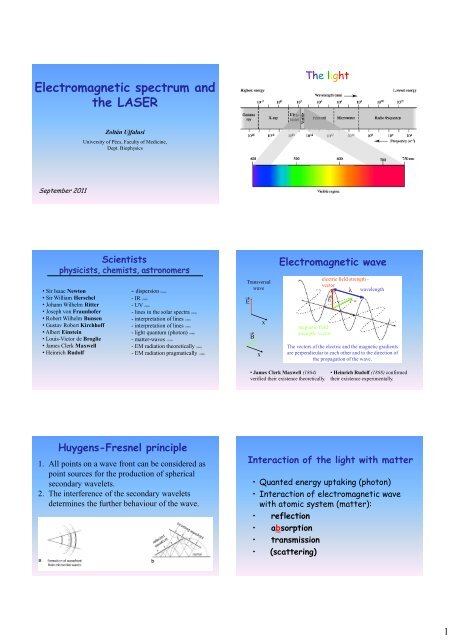
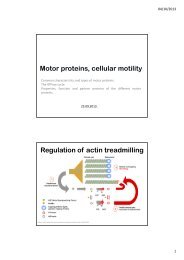
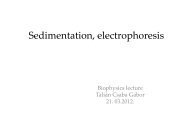
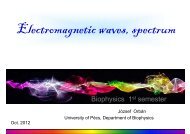

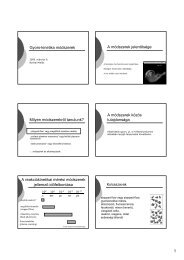


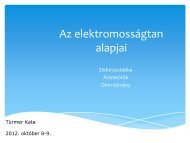



![Microsoft PowerPoint - Intermedier filamentumok [Kompatibilis m\363d]](https://img.yumpu.com/17119137/1/190x135/microsoft-powerpoint-intermedier-filamentumok-kompatibilis-m363d.jpg?quality=85)
